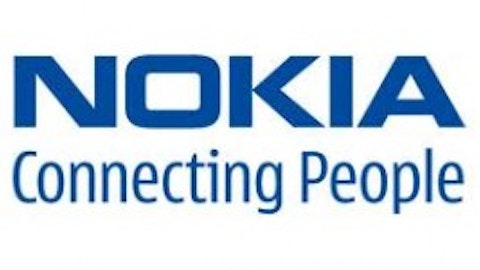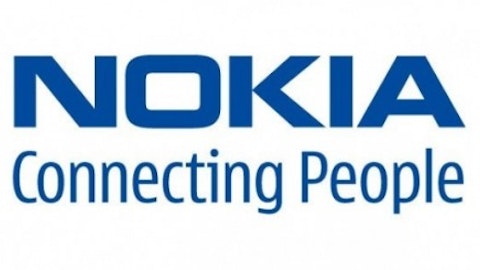
“When we talk about graphene, we’ve reached a tipping point. We’re now looking at the beginning of a graphene revolution… Before this point in time, we figured out a way to manufacture cheap iron that led to the Industrial Revolution. Then there was silicon. Now it’s time for graphene.”
Nokia has many reasons to be bullish on graphene, especially since they received a large sum from the $1.36 billion grant provided by the European Union that was allocated to further develop and research the material. Graphene is 300 times stronger than steel, harder than diamonds, is the thinnest and lightest material (one atom thick) ever obtained by man, is transparent, and conducts electricity better than copper.
Sounds like a tech company’s dream come true? It does to Nokia, which will most likely apply the technology to a range of different things relating to its handset and telecommunications businesses.
And they are not alone…
International Business Machines Corp. (NYSE:IBM) seems to be pushing the innovation level higher with graphene already. The company recently patented “a one atom-thick graphene transistor that works 1,000 times faster than silicon”. That sounds like a major game-changer if I’ve ever heard one. Imagine how explosive innovation and growth in technology will be if this graphene technology works out for “Big Blue.” Silicon might become obsolete. Regarding commercial enterprises, IBM is in second place in the patent race.
Samsung (NASDAQOTH: SSNLF) is in first place for patents, and is looking to invest in graphene even further. The company is now funding research to develop a “graphene-based antennae for intra-chip communication in the terahertz band.” The company is handing out a $120,000 grant to help develop coding and “modulation schemes necessary for wireless, internal communication at hundreds of gigabytes per second among the thousands of sub-processors of a multi-core chip.” These speeds that are impossible today may be made possible with the help of graphene.
IBM and Samsung are leading in the race for patents and are already looking for ways to utilize the impressive substance.
Not just for chips, either…
Graphene also has implications for other industries and applications as well. What about batteries? Super capacitors made with graphene apparently have the potential to make the batteries of today look Stone-Aged. UCLA researchers have found a way to create a super capacitor composed of the carbon-based material that can be charged quicker and holds more electricity than the traditional battery– while also being biodegradable and even compostable.
Think of the implications for tablets and smart phones. What about electric vehicles? The whole media drama between Tesla Motors Inc (NASDAQ: TSLA) CEO Elon Musk and the New York Times may seem like a laughably ridiculous and unnecessary occurrence of the past if graphene makes it possible to charge an electric vehicle as quick as it takes to fill-up a tank of gas — while also being able to travel the same distance as a gas-powered car as well.
Is it all hype?
Graphene sounds like a miracle substance– but is it too good to be true? The knowledge regarding the material, as well as the full extent of its applications and practical uses, is still in its infancy. If the stuff lives up to the hype, we may very well be at what Nokia called the “beginning of a graphene revolution.” IBM and Samsung — just to name a few — are companies that, like Nokia, seem to have lot of faith in graphene.
Like the substance itself, however, it seems that investing in graphene is still in its infancy as well. One discounted, more speculative play that may be at a great advantage to benefit from the potential “graphene revolution” directly, however, is a small-cap that operates as a specialty chemicals and performance materials company.
Pioneering graphene-based battery applications
The rechargeable battery market, according to research firm Avicenne, is poised to reach $18 billion by 2020. The small-cap company, Cabot Corp (NYSE:CBT) is likely to benefit greatly from this trend. With its LITX G700 conductive graphene-based additive, the company has released an additive for high energy density battery applications that can be used in electric vehicles.
The company has also recently released a second product, the LITX-200 additive, “which was designed to get the most power from a lithium-ion battery without compromising energy density or increasing cost.” This additive is intended for use in conjunction with tablets, hybrid EVs, and smartphones.
Conclusion
Cabot Corp (NYSE:CBT) is more of a lithium-ion battery maker than a pure graphene play as of now, but the company is gaining an advantage in its market by pioneering the use of graphene as an additive for high-density battery applications. The company is also looking to develop and innovate even further with the substance, as well. The company’s Chief Technology Officer, Yakov Kutsovsky had this to say:
“We recognize that graphenes have the potential to improve performance in a number of applications from advanced batteries to conductive plastics and tires. We see it also leading to new, stronger composite materials… Cabot has made and continues to make investments in graphene technology. This enables us to have a robust platform capability in which to test and further develop graphene materials.”
Cabot Corp (NYSE:CBT) currently trades at a low P/E ratio around 6 and offers investors a dividend yield of 2.1%, according to Yahoo! Finance, and is a company that will give you exposure to graphene going forward — by further developing the technology and also utilizing it to enhance their existing products.
The article This Small-Cap Will Help You Profit From the Next Big Thing originally appeared on Fool.com and is written by Joseph Harry.
Copyright © 1995 – 2013 The Motley Fool, LLC. All rights reserved. The Motley Fool has a disclosure policy.





